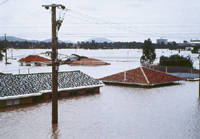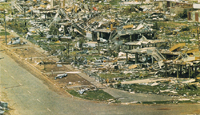


Australian Meteorology through the 20th Century
Introduction
The Origins of Australian Meteorology
Meteorology in the 20th Century
The Weather and Climate of the Twentieth Century
The Great Weather and Climate Events of the Twentieth Century
The Federation Drought, 1895–1902
The Mackay Cyclone of 1918
Northeastern Tasmanian Floods, April 1929
Black Friday in Victoria, January 1939
Record Floods in New South Wales, February 1955
Fire and Storm—Southwest WA, 1961, 1978
Brisbane Floods, January 1974
Cyclone Tracy, Christmas 1974
The 1982–83 Drought
Ash Wednesday Fires, February 1983
Sydney Hailstorm, April 1999
A Century of Progress in Science and Service
References
Australian Meteorological Milestones of the 20th Century
Endnotes
Index
Search
Help
Contact us

Brisbane Floods, January 1974
Following a very wet 1973, the month of January 1974 featured probably the biggest continent-wide drenching since European settlement, with vast areas of the country inundated. In Brisbane, preceding heavy rain had already produced some flooding when, on 24 January, cyclone Wanda came ashore north of the city. Wanda inflicted relatively little wind damage, but produced record rains over the Australia Day weekend. In three days, Brisbane received 580mm, with much higher falls over river catchments near the city (1,300mm in five days at Mt Glorious). Many houses bordering rivers and creeks were washed away as rivers rose to their highest levels since the disastrous 1893 floods (Figure 14). Fourteen people died, some trapped in offices by the rising waters.
Cyclone Tracy, Christmas 1974
The year 1974 started with cyclone Wanda bringing devastating floods to Brisbane, and ended with Darwin devastated by cyclone Tracy. Small but compact by world standards, Tracy packed unusually strong winds (gusts to 217km/h at Darwin Airport before the recorder failed). Tracy moved in from the Arafura Sea, skirted Bathurst Island, then, swinging sharply south, struck Darwin early on Christmas Day. Good warnings had been issued, but the combination of public indifference (it was Christmas and no severe cyclone had affected Darwin for years), extremely fierce winds, and the loose design of many buildings at that time, led to wholesale destruction. Sixty-five people died and most buildings were totally destroyed or badly damaged (Figure 15). Most of the remaining population was swiftly evacuated. In the wake of Tracy, much more attention was given to building codes and other aspects of disaster planning.
 |
Bureau of Meteorology |  |
© Online Edition Australian Science and Technology Heritage Centre and Bureau of Meteorology 2001
Published by Australian Science and Technology Heritage Centre, using the Web Academic Resource Publisher
http://www.austehc.unimelb.edu.au/fam/1611.html